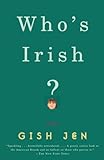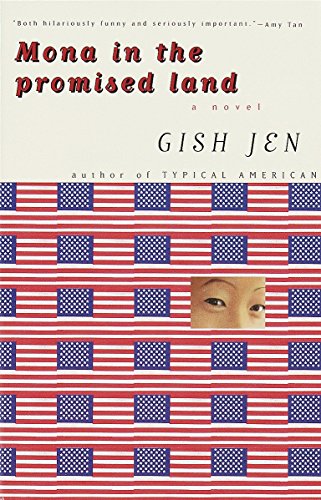The characters of Thank You, Mr. Nixon, Gish Jen’s expansive new collection of superconnected short stories, are restless. They leave China for America and return, leave America for China and return, traveling between the two countries and cultures as if through a revolving door. Jen, like the second-generation Americans in her book, understands what it is to be “hybrid,” and the inherent tension that requires her characters to engage in frequent acts of translation—linguistic, cultural, and generational—whether they wish to or not.
 Born on Long Island in 1955, Jen says she came of age “at the height of multiculturalism, when I was supposed to be writing about my Chinese roots.” But growing up in Scarsdale, N.Y., she learned more Yiddish than Chinese—an experience she mined for her very funny second novel, 1996’s Mona in the Promised Land, about a Chinese girl converting to Judaism.
Born on Long Island in 1955, Jen says she came of age “at the height of multiculturalism, when I was supposed to be writing about my Chinese roots.” But growing up in Scarsdale, N.Y., she learned more Yiddish than Chinese—an experience she mined for her very funny second novel, 1996’s Mona in the Promised Land, about a Chinese girl converting to Judaism.
 “Once that was published, many people were convinced that I must be Jewish,” Jen says over Zoom from an office at Harvard, her alma mater, where she’s a visiting professor in English. “So much so that I began to feel positively lapsed in the fall, when I failed to observe the High Holy Days.”
“Once that was published, many people were convinced that I must be Jewish,” Jen says over Zoom from an office at Harvard, her alma mater, where she’s a visiting professor in English. “So much so that I began to feel positively lapsed in the fall, when I failed to observe the High Holy Days.”
Since she first began publishing short stories in the 1980s (many selected for the Best American series), Jen has had a reputation for writing vivid, smart, often humorous portrayals of second-generation Chinese Americans. She has long been interested in, and has lectured and written about, hybridity, most recently in her 2017 nonfiction book, The Girl at the Baggage Claim: Explaining the East-West Culture Gap.
Thank You, Mr. Nixon could itself be called hybrid: 11 stories threaded so carefully together that they become as interdependent as they are independent, almost novelistic. Jen calls the connectivity a “very complicated network.”
In one sense the book is simple: the stories run chronologically, beginning with the title tale, a letter sent from heaven to hell. In it, a dead Chinese woman thanks the disgraced American president for what he unleashed on his 1972 trip to China. This missive sets the book’s dramas and concerns in motion (the symbiosis of capitalism and communism, for one), and introduces the two families—the Hsus and the Koos—whose various ties give the book its novelistic breadth.
“With stories, there’s a suggestion that there’s so much more than what we see on the page,” Jen says. “We catch a glimpse here, a glimpse there, we see they’re connected, but whoa, there’s a big, big, big thing underwater that will probably take another century to understand.”
 That leviathan is China’s role in the world. There’s the country Jen herself experienced as a “foreign expert” in 1981, teaching English to coal-mining institute students who’d never seen a refrigerator—and the country that became, one generation later, an economic and geopolitical powerhouse.
That leviathan is China’s role in the world. There’s the country Jen herself experienced as a “foreign expert” in 1981, teaching English to coal-mining institute students who’d never seen a refrigerator—and the country that became, one generation later, an economic and geopolitical powerhouse.
“Who could have seen the meteoric rise?” Jen says, still awed by the change. “I don’t think the Chinese even saw it.” Her stories trace that rise—what she calls, “this kind of low-grade rumbling beneath the lives” of her characters.
By choosing to include in this book “Duncan in China” (from her previous collection, Who’s Irish, published in 1999), Jen makes the Hsu family a lodestar, their presence seen or felt in every tale. (Second-generation Chinese-American brothers Duncan and Arnie Hsu move with particular fluidity between the U.S. and China.)
“Frankly, today, I was not going to be able to write a new story about that period that captured it as well as my old story did,” Jen explains. “I was there. The material looks so different in this context. Now we understand that it was just one step in this huge process.”
In these stories, globalization is both poignant and hilarious. Readers of Who’s Irish will recall hapless young Duncan’s exploits as a foreign expert, clashing with his watchful boss and spending more time showing off his bathroom than teaching English. When he falls for an older student, a report is written and she vanishes, only to surprise him later with an offering that changes his life. The full impact of her gesture isn’t felt until several stories later, in “Amaryllis,” about a single, middle-aged, mixed-race, second-generation Chinese American woman working for the Koos in Manhattan and caring for Duncan Hsu’s aging father in east Brooklyn. Mr. Hsu’s nomadic children and grandchildren have largely abandoned him. Lonely Amaryllis wants a connection but only finds it when she stops looking.
Amaryllis is only four in the collection’s long and powerful second story, “It’s the Great Wall!” She’s left with her Caribbean Sephardic Jewish grandparents while her parents take her Chinese grandmother, Opal, to China for the first time since she immigrated to America decades ago. As part of an organized group of mostly Western tourists, Opal tires of translating for the struggling guide, but her understanding of the guide’s “heart” helps her navigate the People’s Republic in ways the others, including her own daughter, cannot. This makes possible a clandestine reunion with the family Opal left behind, an unexpected turn that takes the story in a crushingly poignant direction.
The Hsus and Koos are intricately entwined in “Rothko, Rothko,” wherein Rich Lee, a broke creative writing teacher with a novel in a drawer hopes to profit from the forgeries of a talented Chinese artist, despite warnings from his lawyer wife, Arabella.
In “No More Maybe,” the story that follows, Arabella is now representing a Chinese family whose visa status has lapsed; this tale, set during the Trump years, vividly evokes the rising anxiety of undocumented immigrants in America.
And in the long, extremely funny “Gratitude,” a former student of Rich’s, Bobby Koo, tries to maintain the (8,000-mile) distance she’s put between her and her parents. Unhappy with their “number one daughter” ghosting them, the Koos outsmart her: they plan to buy her apartment through a proxy (Duncan Hsu’s brother, Arnie), fly from Hong Kong to America, and surprise her at the closing. The reunion does not play out as they’d hoped.
“I felt a responsibility to get the details right,” Jen says of the book, and many of the stories contain vivid details of a China that no longer exists; she pulled from extensive notes taken on a family trip in 1979 and her foreign-expert stint two years later. “I was there,” Jen says again. “I was a witness, and I take that seriously.”
Her command of detail makes Thank You, Mr. Nixon authentic and engrossing; her vision makes it unique and vital. “I’ve been writing all these stories in this changing world that involve mainland immigrants—stories that 30 years earlier wouldn’t have been possible,” Jen says. “Because there were no immigrants. They wouldn’t have been here—much less in law school.”
She throws up her hands and laughs. “I am very, very, very lucky that my career has coincided with these changes.”
This piece was produced in partnership with Publishers Weekly.











